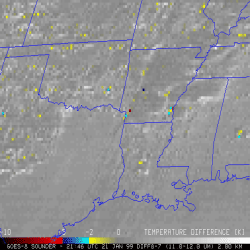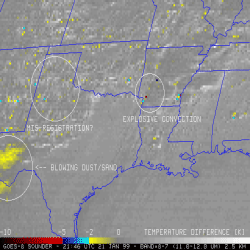

| |
|
|---|---|
| |
|
 |
|
 |
 |
| Sounder IR Band 8 image at 21:46 UTC 21 Jan 1999 | Sounder Difference of Band 8-7 at 21:46 21 UTC Jan 1999 |
| Java applet animation of Band 8-7 | |
 |
 |
| Imager Difference of Bands 4-5 at 21:45 UTC Jan 21 1999 | |
| Java applet animation of Band 4-5 |
There
may be 3 reasons for the negative 11-12 micron differences in the above images:
In general, there may be 3 other reasons that the split window may report a
negative difference:
Yet, the fact that different instruments (GOES imager and sounder, MAS and HIS ) all can report a negative difference, this is less likely.
The 11-12 micron difference was described in:
Moeller, C., S. A. Ackerman, K. I. Strabala, W. P. Menzel, and W. L.
Smith, 1996: Negative 11 micron minus 12 micron brightness temperature
differences: A second look. AMS Eighth Conference on Satellite Meteorology
and Oceanography, Atlanta, GA, 27 January - 2 February 1996.
For an example of negative 11-12 micron difference from the HIS:
GOES Gallery 21 January 1999 Blowing Dust Event over N. Mexico and the Southwestern U.S.